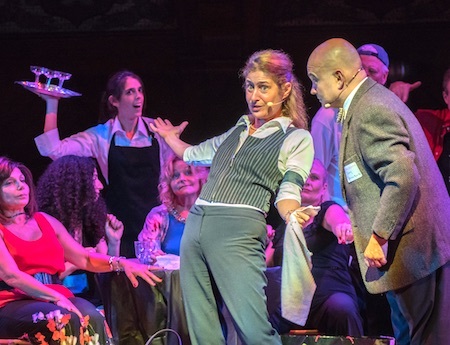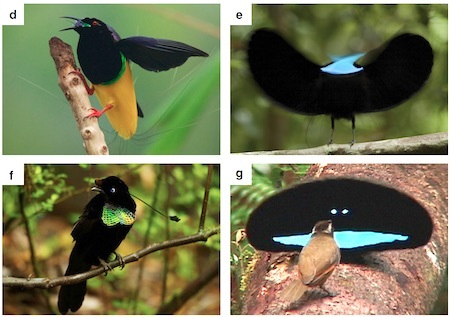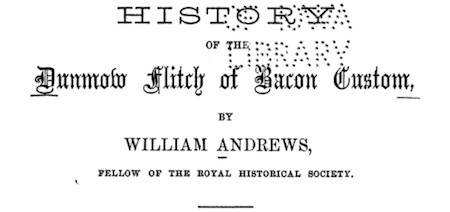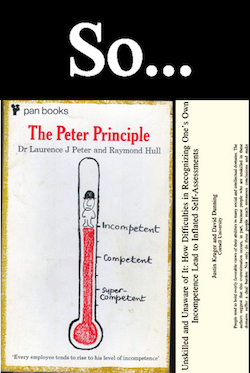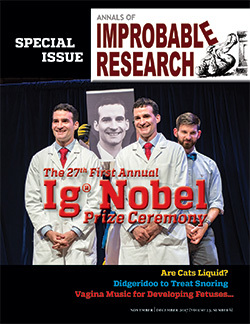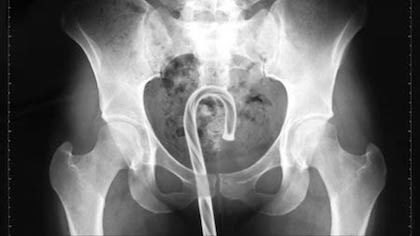Marc Abrahams's Blog, page 198
January 12, 2018
Chris Christie’s “Analysis of the Indexical Values of Swearwords”
To study how people deploy swear words, there are always more depths to be plumbed. This study plumbs:
“The Relevance of Taboo Language: An Analysis of the Indexical Values of Swearwords,” Christine Christie, Journal of Pragmatics, vol. 58, 2013, pp. 152-169. The author explains:
“The assumption that the use of a particular word or linguistic resource can produce (im)politeness effects in some contexts, but not in all, is uncontroversial. For example, scholarship that addresses swearing as (im)politeness behaviour has repeatedly shown that, as a resource, taboo language can be used to generate a number of communicative effects in different contexts…. There are many questions about the indexing potential of strong swearwords, and how it relates to the location of different metadiscourses of swearing that have yet to be addressed.”

January 11, 2018
Dakota McCoy and the Blacker-Than-Black Bird Plumage
Biologist Dakota McCoy, (seen here performing with a tray of drinks in hand, in “The Incompetence Opera,” part of the Ig Nobel Prize ceremony) has a new study about color in birds. McCoy, together with colleagues Teresa Feo, Todd Alan Harvey, and Richard O. Prum, published “Structural absorption by barbule microstructures of super black bird of paradise feathers,” in the journal Nature Communications.
Ed Yong, in The Atlantic magazine, writes an appreciation of the study:
Super-Black Is the New Black
Feathers on birds of paradise contain light-trapping nanotechnology that makes some of the deepest blacks in the world.
Blackbirds, it turns out, aren’t actually all that black. Their feathers absorb most of the visible light that hits them, but still reflect between 3 and 5 percent of it. For really black plumage, you need to travel to Papua New Guinea and track down the birds of paradise.
Although these birds are best known for their gaudy, kaleidoscopic colors, some species also have profoundly black feathers. The feathers ruthlessly swallow light and, with it, all hints of edge or contour. They make body parts seem less like parts of an actual animal and more like gaping voids in reality. They’re blacker than black….
Here are some images from the study:

January 5, 2018
Marriage, bacon, and the law, customarily in England
History of the Dunmow Flitch of Bacon Custom, a book by William Andrews, published in 1877, tells of the British custom involving married couples publicly swearing an oath about themselves, in pursuit of free bacon.
“The Dunmow Flitch: bringing home the bacon,” written more recently, by a mildly-anonymous someone else, also tells some history of the custom. That telling is in a 2012 edition of the Essex Voices Past blog:
“This Saturday, 14 July 2012, heralds the much awaited ancient custom of The Dunmow Flitch whereby couples from all over Britain (and, in recent years, the world) come to Dunmow to persuade a formal court that they have not wished themselves unwed for a year and day. If they win the court case, and persuade the judge and jury of their love for each other, then they win a ‘flitch of bacon’ (a large side of cured pig). This court is very formal with a judge, jury and barristers: one barrister defends the Pig, and the other is for the couple. Any couple who wins the Flitch is said to be ‘bringing home the bacon’ and is carried aloft on the ancient Dunmow Flitch chair by ‘yeomans’ in a parade through the streets of the town . Once the parade arrives in the market place, the winners of the Flitch have to kneel on pointed stones and say The Oath.”
The Flitch Oath
You shall swear by the Custom of our Confession
That you never made any Nuptial Transgression
Since you were married Man and Wife
By Household Brawls or Contentious Strife
Or otherwise in Bed or at Board
Offended each other in deed or in word
Or since the Parish Clerk said Amen
Wished yourselves unmarried again
Or in a Twelvemonth and a day.
Repented not in thought any way
But continued true and in Desire
As when you joined Hands in holy Quire
The Sentence
If to these Conditions without all fear
Of your own accord you will freely swear
A Gammon of Bacon you shall receive
And bear it hence with love and good Leave
For this is our Custom at Dunmow well known
Though the sport be ours, the Bacon’s your own.
[This last line is normally said to great rousing cheers from the watching audience.]
These days, one can, when in the town of Little Dunmow, dine at the Flitch of Bacon restaurant. One can even—even out of the town of Little Dunmow, as well as in it—follow the twitter feed of that eating establishment.
(Thanks to John Overholt for bringing this to our attention.)

January 4, 2018
‘Power Posing’ and the hormone profiles of leaders [research studies]
Back in 2010, a seminal ‘Power Posing’ study from Columbia University and Harvard University in the US revealed :
“That a person can, by assuming two simple 1-min poses, embody power and instantly become more powerful has real-world, actionable implications.”
The research team found that ‘Power Posing’ not only had effects on observers of the poses, but also that the poser’s own hormone balances were changed in the process.
 See Power Posing: Brief Nonverbal Displays Affect Neuroendocrine Levels and Risk Tolerance (Psychological Science 21(10) 1363 –1368).
See Power Posing: Brief Nonverbal Displays Affect Neuroendocrine Levels and Risk Tolerance (Psychological Science 21(10) 1363 –1368).
Looked at from a reverse perspective, might this imply that there could be an optimal hormonal profile for ‘leaders’? Those who wish to further their studies of social neuroendocrinology from a leadership perspective might consult the findings of the NeuroLeadership Insitiute. Here is an example paper* from their NeuroLeadership Journal which reveals :
‘An Ideal Hormone Profile for Leadership’
“Characteristics like respect from peers, resilience, ability to inspire confidence and loyalty, capacity to make tough decisions, and the general attribute of being perceived as a leader can seem like elusive qualities. It turns out that these all can be influenced by a leader’s neuroendocrine systems (e.g. testosterone, cortisol, and oxytocin). Social neuroendocrinology—the study of hormone systems in social contexts—is showing a) that there might be an optimal hormonal profile for leadership, and b) that a person can influence her or his own hormonal profile in the short and long term. These findings hold across gender, type of organization (e.g. sports teams, business), and types of leadership challenges (e.g. negotiation, competition, cooperation).”
Bonus Assignment [optional] If leaders have an optimal hormone profile, would hormone-testing reveal their suitability (or otherwise) for their roles?
*Note: The full paper is only available to members, and the institute is “no longer renewing or accepting new Individual Memberships”.

January 3, 2018
Robot-Trained Water Gait
Robotics are having an effect on water gait, as described in this study:
“Robotic gait trainer in water: Development of an underwater gait-training orthosis,” Tasuku Miyoshi, Kazuaki Hiramatsu, Shin-Ichiro Yamamoto, Kimitaka Nakazawa, and Masami Akai, Disability and Rehabilitation, vol. 30, no. 2, 2008, pp. 81-87. The authors are at the Shibaura Institute of Technology, the Japan Foundation for Aging and Health, Hitachi Medical Corporation, and the Research Institute of National Rehabilitation Center for Persons with Disabilities, Saitama, Japan. They report:
Purpose. To develop a robotic gait trainer that can be used in water (RGTW) and achieve repetitive physiological gait patterns to improve the movement dysfunctions.
Method. The RGTW is a hip-knee-ankle-foot orthosis with pneumatic actuators; the control software was developed on the basis of the angular motions of the hip and knee joint of a healthy subject as he walked in water. Three-dimensional motions and electromyographic (EMG) activities were recorded in nine healthy subjects to evaluate the efficacy of using the RGTW while walking on a treadmill in water.

January 2, 2018
The Value of Bark Codes and Barcodes
Though barcodes are more widely celebrated, bark codes do get some love—rather specialized love. These two reports make both of those facts almost clear.
The Value of Bark Codes: “Discounts for Bark, Color, and Trash in Cotton: Evidence from the Texas-Oklahoma Market,” Dale Shaw, Carlos Engels, Jeff Brown, and Don Ethridge, Proceedings of the Beltwide Cotton Production Conference, 1993, pp. 435-438. The report reports: “Records were extracted on the separate color dimensions (grayness/whiteness (Rd) and yellowness (+b)), classer’s independent trash code, and bark codes for one and two grade reductions as well as reductions for grass, oil, etc.”
The Value of Barcodes: “The Barcode Revolution,” Alan Akeroyd, Journal of the Society of Archivists, vol. 31, 1, 2010, pp.51-62. Akeroyd reports: “Barcodes have only been in existence for 35 years, yet in that time they have become one of the most omnipresent elements in the modern world, underpinning every aspect of the global economy.”

Tapeworms from Vertebrate Bowels of the Earth, appreciated
Though tapeworms tend to live sequestered lives, those lives can be—and now have been—contemplated panoramically.
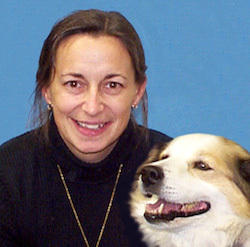 Planetary Biodiversity Inventory (2008-2017): Tapeworms from Vertebrate Bowels of the Earth, compiles info about tapeworms from the bowels of many vertebrates. The book is a collaboration of Janine N. Caira [pictured here] and Kirsten Jensen, published in 2017 [University of Kansas, Natural History Museum, Special Publication No. 25].
Planetary Biodiversity Inventory (2008-2017): Tapeworms from Vertebrate Bowels of the Earth, compiles info about tapeworms from the bowels of many vertebrates. The book is a collaboration of Janine N. Caira [pictured here] and Kirsten Jensen, published in 2017 [University of Kansas, Natural History Museum, Special Publication No. 25].
Sarah Kaplan compiled an appreciation of Caira and Jenson and their compilation, in the Washington Post:
“In 2017, Caira released her magnum opus: “Tapeworms from Vertebrate Bowels of the Earth.” The 463-page volume, which Caira edited with University of Kansas scientist Kirsten Jensen, is the result of a eight-year effort to survey the intestinal parasites of animals from around the world. The book inventories 4,810 species collected from two oceans and every continent except Antarctica. It also introduces 211 species that are entirely new to science. “We’re very proud,” Caira says. “Bowels of the Earth” is no metaphor. Caira and some three dozen fellow scientists gutted an estimated 14,884 fish, frogs, lizards, snakes, mammals and birds for this project. They traversed grasslands, waded through marshes and trekked across ice.”

January 1, 2018
Beer pipeline derivatives (economics study)
“In 2016, the Belgian brewery De Halve Maan (DHM) completed the construction of a pipeline that now transports beer from its brewery in Bruges to its bottling plant located in a modern industrial park 3.2 kilometers away.”
An unusual aspect of the project was that it was partly crowdfunded via a scheme which gave investors a specified amount of beer per year for the rest of his or her life.
For those who study business arrangements – in particular derivatives – questions can be asked about the deal, bearing in mind the current and expected future price of beer, and the life expectancy of the investors. Professor Carlos E. Ortiz (Arcadia University), Professor Charles A. Stone (Brooklyn College) and Professor Anne Zissu (City Tech) have examined the case, and developed a valuation model.
“While we do not know the age distribution of the funders, the life expectancy data clearly have implications for the value on both sides of the transaction. The data imply that an 80-year-old man who bought the beer annuity can expect a bottle of beer a day for the next 8.2 years and a man between 20 and 24 years of age can expect the beer to flow for another 59.1 years. The price of the annuity was the same for both men. Older beer drinkers subsidize younger beer drinkers. Of course, pricing the annuities according to life expectancy, while perhaps attracting younger investors, could just as likely drive away older wealthier people who invested in the project.”
See Beer Annuities: Hold the Interest and Principal , The Journal of Derivatives, Summer 2017, 24 (4) 108-114

December 30, 2017
The Incompetence Opera (including the Dunning-Kruger song)
Here’s video of the premier performance of “The Incompetence Opera”:
“The Incompetence Opera” is a musical encounter with the Peter Principle and the Dunning-Kruger Effect.
And with the word “so.”
This opera premiere was part of the 27th First Annual Ig Nobel Prize ceremony, September 14, 2017, at Sanders Theatre, Harvard University.
The opera is composed of three short acts. “The Dunning Kruger Song” is the final act.
The entire opera libretto was printed in IgBill, the program that was handed out to the 1100 audience members in Sanders Theatre that evening. You can download IgBill as a PDF.
The libretto is also included in the special Ig Nobel issue (vol. 23, no. 6, November/December 2017) of the magazine Annals of Improbable Research.

December 29, 2017
Further findings from rectums: A look back at what was in behinds
Barry Petchevsky performed his annual data-gathering exercise “What Did We Get Stuck In Our Rectums Last Year?” in Deadspin:
All reports are taken from the U.S. Consumer Product Safety Commission’s database of emergency room visits, and they are occasionally not for the faint of spirit….
GOLF BALL
PEANUT BUTTER JAR
SPRAY BOTTLE
CURTAIN ROD
“STUCK A TOY UP HIS RECTUM BECAUSE HE THOUGHT HE WAS CONSTIPATED”
TOOTHBRUSH
TOOTHBRUSH HOLDER
…
Petchevsky’s prodigious mining operation is in the tradition of the medical study that won the 1995 Ig Nobel Literature Prize. That prize was awarded to surgeons David B. Busch and James R. Starling, of Madison Wisconsin, for their deeply penetrating research report, “Rectal foreign bodies: Case Reports and a Comprehensive Review of the World’s Literature,” published in the journal Surgery (September 1986, pp. 512-519).
The Busch/Starling compendium include reports of, among other items: seven light bulbs; a knife sharpener; two flashlights; a wire spring; a snuff box; an oil can with potato stopper; eleven different forms of fruits, vegetables and other foodstuffs; a jeweler’s saw; a frozen pig’s tail; a tin cup; a beer glass; and one patient’s remarkable ensemble collection consisting of spectacles, a suitcase key, a tobacco pouch and a magazine.
The Busch/Starling compendium contains multitudes. It bears repeat visits.

Marc Abrahams's Blog
- Marc Abrahams's profile
- 14 followers



